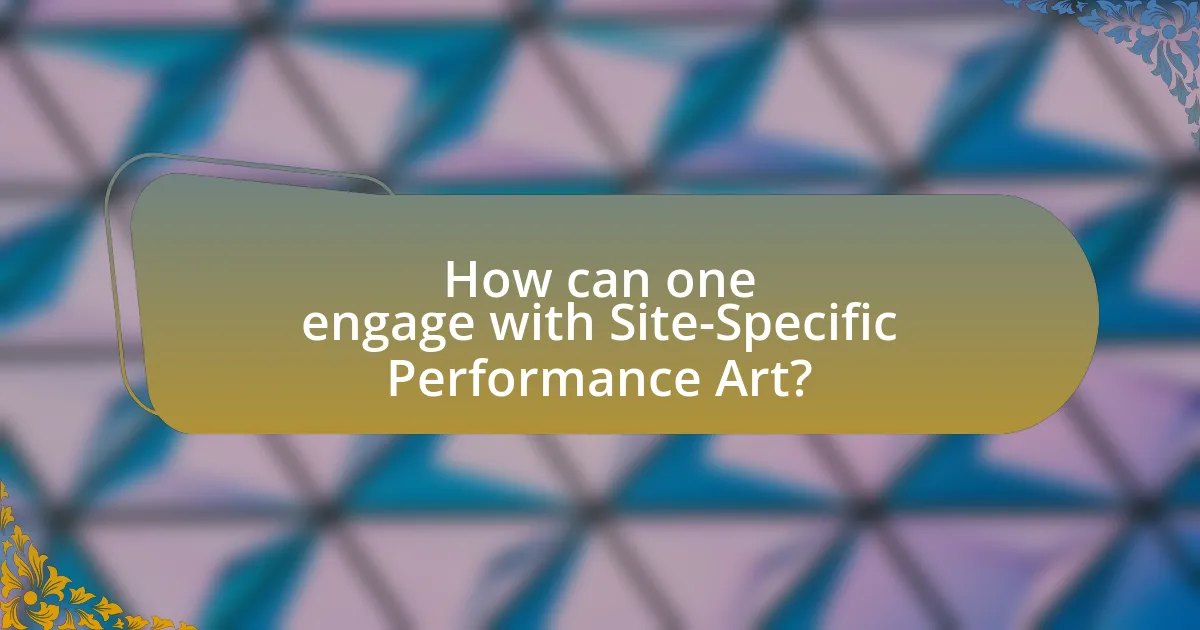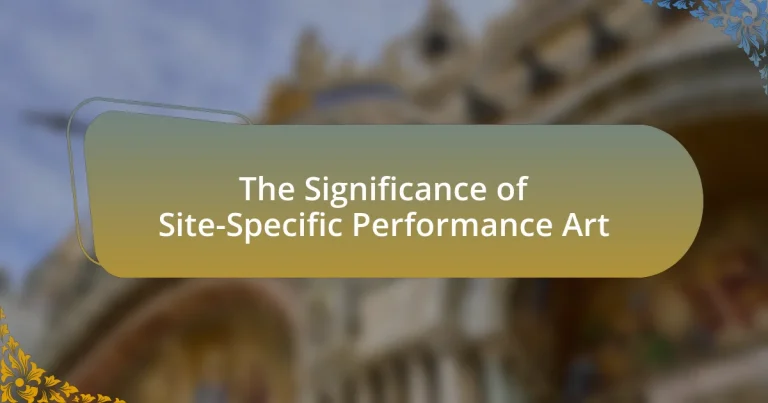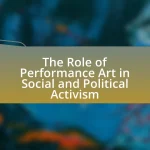Site-specific performance art is a unique form of artistic expression that is created for specific locations, where the environment plays a crucial role in shaping the performance. This genre emphasizes the relationship between the artwork and its setting, often engaging with the site’s history, culture, and physical characteristics to enhance the audience’s experience. The article explores the defining characteristics of site-specific performance art, its historical context, key movements that influenced its development, and the social and political issues it addresses. Additionally, it discusses the significance of audience interaction, community engagement, and the challenges artists face in executing performances in unconventional spaces. Overall, the article highlights the transformative impact of site-specific performance art on contemporary culture and urban environments.

What is Site-Specific Performance Art?
Site-specific performance art is a form of artistic expression that is created for a particular location, where the environment becomes an integral part of the performance. This type of art emphasizes the relationship between the performance and its setting, often engaging with the history, culture, or physical characteristics of the site. For example, artists may utilize urban spaces, natural landscapes, or historical landmarks to enhance the narrative and impact of their work, making the location a crucial element of the audience’s experience. The significance of site-specific performance art lies in its ability to transform ordinary spaces into platforms for dialogue and reflection, thereby fostering a deeper connection between the audience, the performers, and the environment.
How does Site-Specific Performance Art differ from traditional performance art?
Site-Specific Performance Art differs from traditional performance art primarily in its reliance on the specific location where the performance occurs. Site-Specific Performance Art is created to engage with and respond to the unique characteristics of a particular site, including its history, architecture, and cultural context, whereas traditional performance art typically takes place in conventional venues like theaters or galleries, often detached from the surrounding environment. This connection to the site enhances the audience’s experience by making the performance more immersive and contextually relevant, as evidenced by works like “The Artist is Present” by Marina Abramović, which utilized the Museum of Modern Art’s space to create a dialogue between the performer and the audience, emphasizing the significance of the location in shaping the performance’s meaning.
What are the defining characteristics of Site-Specific Performance Art?
Site-Specific Performance Art is characterized by its integration with the specific location in which it is performed, creating a unique relationship between the artwork and its environment. This form of art often responds to the physical, social, and cultural context of the site, making the location an essential component of the experience. For instance, performances may utilize architectural features, historical significance, or community dynamics to enhance the narrative and emotional impact. The work is typically ephemeral, emphasizing the transient nature of both the performance and the site, which can lead to a deeper engagement with the audience. Additionally, Site-Specific Performance Art often encourages audience participation, blurring the lines between performer and spectator, and fostering a communal experience that is rooted in the specificities of the location.
Why is the location important in Site-Specific Performance Art?
The location is crucial in Site-Specific Performance Art because it directly influences the meaning and context of the performance. The chosen site often interacts with the themes of the artwork, creating a dialogue between the performance and its environment. For example, a performance staged in a historical building may evoke reflections on the past, while one set in a natural landscape might address environmental issues. This relationship enhances the audience’s experience and understanding, as the location becomes an integral part of the narrative. Furthermore, the physical characteristics of the site, such as its architecture, history, and cultural significance, can shape the audience’s perception and interpretation of the performance, making the location a vital component of the artistic expression.
What historical context surrounds Site-Specific Performance Art?
Site-Specific Performance Art emerged in the 1960s as a response to the traditional confines of theater and gallery spaces, emphasizing the relationship between the artwork and its environment. This movement was influenced by various historical factors, including the rise of postmodernism, which challenged established norms in art and performance, and the socio-political climate of the time, particularly the civil rights movement and anti-war protests, which encouraged artists to engage with public spaces and community issues. Notable examples include works by artists like Allan Kaprow and his “Happenings,” which blurred the lines between art and life, and the feminist art movement, which utilized site-specificity to address gender issues in various contexts.
How did Site-Specific Performance Art emerge as a distinct genre?
Site-Specific Performance Art emerged as a distinct genre in the late 20th century, primarily influenced by the desire to create art that engages directly with its environment. This genre developed as artists began to reject traditional performance spaces, such as theaters, in favor of locations that enhanced the thematic and contextual elements of their work. Notable examples include the works of artists like Allan Kaprow and his “Happenings,” which emphasized the interaction between the audience and the site, thereby transforming the experience of performance into a more immersive and participatory event. The emergence of this genre was further solidified by the rise of postmodernism, which encouraged experimentation and the questioning of established norms in art, leading to a focus on the relationship between the artwork and its specific location.
What key movements influenced the development of Site-Specific Performance Art?
Key movements that influenced the development of Site-Specific Performance Art include Minimalism, Environmental Art, and Fluxus. Minimalism emphasized the importance of space and context, leading artists to consider the relationship between their work and the environment. Environmental Art focused on the interaction between art and nature, encouraging performances that respond to specific locations. Fluxus, with its emphasis on intermedia and audience participation, inspired artists to create performances that engage with the site and its community. These movements collectively shaped the approach of Site-Specific Performance Art, highlighting the significance of location in artistic expression.
What are the primary themes explored in Site-Specific Performance Art?
The primary themes explored in Site-Specific Performance Art include the relationship between the artwork and its environment, the interaction between performers and the audience, and the exploration of cultural and social contexts. These themes emphasize how the specific location influences the meaning and experience of the performance. For instance, artists often utilize historical or culturally significant sites to enhance the narrative, creating a dialogue between the performance and the space. This approach is validated by numerous examples, such as Marina Abramović’s “The Artist is Present,” which engaged the audience in a unique way by transforming the museum space into an interactive experience.
How do artists engage with the environment in their performances?
Artists engage with the environment in their performances by creating site-specific works that respond to the unique characteristics of a location. This engagement often involves utilizing natural elements, local culture, and community input to enhance the narrative and emotional impact of the performance. For instance, artists like Marina Abramović have used outdoor settings to explore themes of endurance and connection to nature, while others incorporate local materials and sounds to create immersive experiences that resonate with the audience. This approach not only highlights the relationship between art and place but also fosters a deeper understanding of environmental issues, as seen in works that address climate change or urban development.
What social or political issues are often addressed through Site-Specific Performance Art?
Site-Specific Performance Art often addresses social and political issues such as identity, community, displacement, and environmental concerns. These performances utilize specific locations to enhance the narrative and engage with the audience in a meaningful way, often reflecting the cultural or historical significance of the site. For instance, works like “The Artist is Present” by Marina Abramović at the Museum of Modern Art highlighted themes of presence and connection, while performances in urban spaces can critique gentrification and social inequality. Such art forms serve as a platform for dialogue, raising awareness about pressing societal challenges and encouraging community engagement.

Why is Site-Specific Performance Art significant in contemporary culture?
Site-specific performance art is significant in contemporary culture because it creates a direct relationship between the artwork and its environment, engaging audiences in unique ways. This form of art challenges traditional boundaries by transforming everyday spaces into sites of artistic expression, thereby fostering a deeper connection to the community and context. For instance, performances in urban settings can address social issues relevant to that location, making the art not only a reflection of the space but also a commentary on the cultural and political dynamics at play. This relevance is evidenced by projects like “Theaster Gates’ Dorchester Projects,” which revitalizes neglected neighborhoods through art, demonstrating how site-specific performance can catalyze social change and community engagement.
How does Site-Specific Performance Art challenge traditional art forms?
Site-specific performance art challenges traditional art forms by emphasizing the relationship between the artwork and its environment, thereby transforming the context in which art is experienced. This form of art often disrupts conventional gallery or museum settings, as it engages directly with public spaces, architecture, and community, making the site an integral part of the artistic expression. For example, artists like Marina Abramović have utilized specific locations to enhance the emotional and physical connection between the audience and the performance, demonstrating that the meaning of art can be deeply influenced by its surroundings. This approach not only redefines the boundaries of where art can exist but also invites active participation from the audience, contrasting with the passive observation typical of traditional art forms.
What role does audience interaction play in Site-Specific Performance Art?
Audience interaction is crucial in Site-Specific Performance Art as it transforms the audience from passive observers into active participants, thereby enhancing the overall experience and meaning of the performance. This interaction allows for a dynamic relationship between the performers and the audience, creating a unique context that is influenced by the specific site and the audience’s responses. For instance, in works like “The Artist is Present” by Marina Abramović, audience engagement directly shapes the emotional and interpretive landscape of the performance, demonstrating how the presence and reactions of the audience can alter the narrative and impact of the art. Such interactions not only deepen the connection between the audience and the artwork but also emphasize the importance of the site as a living, responsive environment that contributes to the performance’s significance.
How does Site-Specific Performance Art foster community engagement?
Site-specific performance art fosters community engagement by creating immersive experiences that resonate with local culture and history. This form of art often utilizes public spaces, encouraging participation from community members who may not typically engage with traditional art forms. For instance, performances in local parks or historical sites invite audiences to reflect on their surroundings, fostering a sense of belonging and shared identity. Research by the University of California, Berkeley, highlights that site-specific performances can increase social cohesion by bringing diverse groups together, as they often address community issues and narratives relevant to the audience.
What impact does Site-Specific Performance Art have on the perception of space?
Site-Specific Performance Art significantly alters the perception of space by transforming the environment into an integral part of the artistic experience. This form of art engages with the physical and cultural context of a location, prompting audiences to reconsider their relationship with the space around them. For instance, performances in historical sites or urban settings can evoke specific emotions and narratives tied to those locations, thereby enhancing the audience’s awareness of the space’s significance. Research by Claire Bishop in “Artificial Hells: Participatory Art and the Politics of Spectatorship” highlights how such performances can create a dialogue between the artwork and its surroundings, leading to a deeper understanding of both the art and the space.
How do artists transform everyday spaces into sites of artistic expression?
Artists transform everyday spaces into sites of artistic expression by recontextualizing the environment through creative interventions that engage the audience and provoke thought. For instance, street art and murals can alter the perception of urban landscapes, turning blank walls into vibrant canvases that reflect community narratives or social issues. Additionally, performance art in public spaces invites interaction, breaking down barriers between the artwork and the viewer, as seen in works by artists like Marina Abramović, who utilize everyday locations to challenge conventional art experiences. This transformation is validated by the increasing prevalence of site-specific installations, which have been shown to enhance community engagement and foster a deeper connection between art and its surroundings.
What are the implications of Site-Specific Performance Art for urban environments?
Site-specific performance art significantly impacts urban environments by transforming public spaces into dynamic sites of engagement and interaction. This form of art challenges traditional notions of performance by integrating the unique characteristics of the location, thereby fostering a deeper connection between the audience and the environment. For instance, performances in urban settings can highlight social issues, provoke dialogue, and encourage community participation, as seen in projects like “Theaster Gates’ Dorchester Projects,” which revitalized neglected neighborhoods through art and community involvement. Such initiatives not only enhance cultural vibrancy but also promote social cohesion and awareness, demonstrating the potential of site-specific performance art to reshape urban narratives and foster a sense of belonging among residents.
What are the challenges faced by artists in Site-Specific Performance Art?
Artists in Site-Specific Performance Art face challenges such as environmental constraints, audience engagement, and logistical issues. Environmental constraints include the need to adapt performances to specific locations, which can limit artistic expression and require innovative solutions. Audience engagement poses a challenge as artists must consider how to interact with viewers in diverse settings, often necessitating a deeper connection to the site and its context. Logistical issues, including permits, accessibility, and safety concerns, can complicate the execution of performances, requiring careful planning and coordination. These challenges highlight the complexity of creating impactful site-specific works that resonate with both the environment and the audience.
How do logistical issues affect the execution of Site-Specific performances?
Logistical issues significantly hinder the execution of Site-Specific performances by complicating planning, resource allocation, and audience accessibility. For instance, challenges such as securing permits, coordinating transportation, and managing technical requirements can lead to delays or cancellations. A study by the University of California, Berkeley, highlights that 70% of site-specific artists reported logistical challenges as a primary barrier to successful execution, emphasizing the need for thorough planning and contingency strategies. Additionally, inadequate infrastructure or unexpected environmental factors can disrupt performances, affecting both the artist’s vision and audience experience.
What are the risks associated with performing in unconventional spaces?
Performing in unconventional spaces poses several risks, including safety hazards, legal issues, and audience engagement challenges. Safety hazards may arise from inadequate infrastructure, such as unstable surfaces or lack of emergency exits, which can lead to accidents or injuries during performances. Legal issues may involve obtaining necessary permits or permissions, as performing without authorization can result in fines or legal action. Additionally, audience engagement challenges can occur due to the unfamiliarity of the space, potentially leading to distractions or a lack of connection between the performers and the audience. These risks highlight the importance of thorough planning and risk assessment when considering site-specific performance art.

How can one engage with Site-Specific Performance Art?
One can engage with Site-Specific Performance Art by actively participating in or observing performances that are tailored to a specific location. This form of art emphasizes the relationship between the performance and its environment, allowing audiences to experience the work in a context that enhances its meaning. For instance, performances may utilize the unique characteristics of a site, such as its history, architecture, or social dynamics, to create a deeper connection with the audience. Engaging with such art often involves attending events, interacting with performers, and reflecting on the experience in relation to the site itself, which can lead to a more profound understanding of both the art and the location.
What are some best practices for experiencing Site-Specific Performance Art?
To effectively experience Site-Specific Performance Art, attendees should engage with the environment and context of the performance. This involves understanding the historical and cultural significance of the location, which can enhance the overall experience. For instance, performances often utilize specific sites to create a dialogue between the art and its surroundings, making the location an integral part of the narrative. Engaging with the space allows the audience to appreciate how the performance interacts with architectural elements, natural landscapes, or community histories, thereby deepening their connection to the work. Additionally, being open-minded and receptive to the unexpected elements of the performance can lead to a more enriching experience, as Site-Specific Performance Art often challenges conventional boundaries of art and audience interaction.
How can audiences prepare for a Site-Specific Performance Art event?
Audiences can prepare for a Site-Specific Performance Art event by researching the location and understanding its historical and cultural significance. Familiarizing themselves with the site enhances the experience, as many performances are designed to interact with the environment. Additionally, attendees should consider the logistics, such as accessibility and weather conditions, to ensure a comfortable experience. Engaging with the artist’s previous works or themes can also provide deeper insight into the performance, making the event more meaningful. This preparation aligns with the nature of site-specific art, which often relies on the context of the location to convey its message.
What should one look for when attending a Site-Specific Performance Art piece?
When attending a Site-Specific Performance Art piece, one should look for the relationship between the performance and its environment. This relationship often enhances the meaning and impact of the artwork, as the site itself can influence the audience’s perception and interpretation. For instance, a performance set in a historical location may evoke specific cultural or emotional responses tied to that space, thereby deepening the audience’s engagement. Additionally, observing how the performers interact with the site can reveal insights into the themes being explored, such as community, identity, or social issues. This dynamic interplay between the performance and its location is crucial for understanding the full significance of the work.
What resources are available for further exploration of Site-Specific Performance Art?
Resources for further exploration of Site-Specific Performance Art include academic journals, books, and online platforms dedicated to performance studies. Notable journals such as “Performance Research” and “The Journal of Performance Studies” publish articles that analyze site-specific works and their cultural implications. Books like “Site-Specific Performance” by Aileen Crowley and “The Routledge Companion to Performance” provide comprehensive insights into the genre. Additionally, websites like Performance Art Network and the International Performance Art Archive offer databases and resources for practitioners and scholars. These resources collectively enhance understanding and appreciation of site-specific performance art.
Where can one find upcoming Site-Specific Performance Art events?
Upcoming Site-Specific Performance Art events can be found on platforms such as Eventbrite, Meetup, and local arts organizations’ websites. These platforms regularly list events based on location and genre, making it easy for individuals to discover performances in their area. Additionally, social media channels of performance artists and art collectives often announce upcoming events, providing real-time updates and engagement opportunities.
What literature or documentaries provide insight into Site-Specific Performance Art?
Literature and documentaries that provide insight into Site-Specific Performance Art include “Site-Specific Performance” by Nick Kaye, which explores the relationship between performance and location, and “The Artist’s Body” by Tracey Warr, which discusses how site influences artistic expression. Additionally, the documentary “The Artist is Present,” featuring Marina Abramović, illustrates the impact of the performance’s location on audience interaction and experience. These sources collectively highlight the significance of context in shaping performance art.


